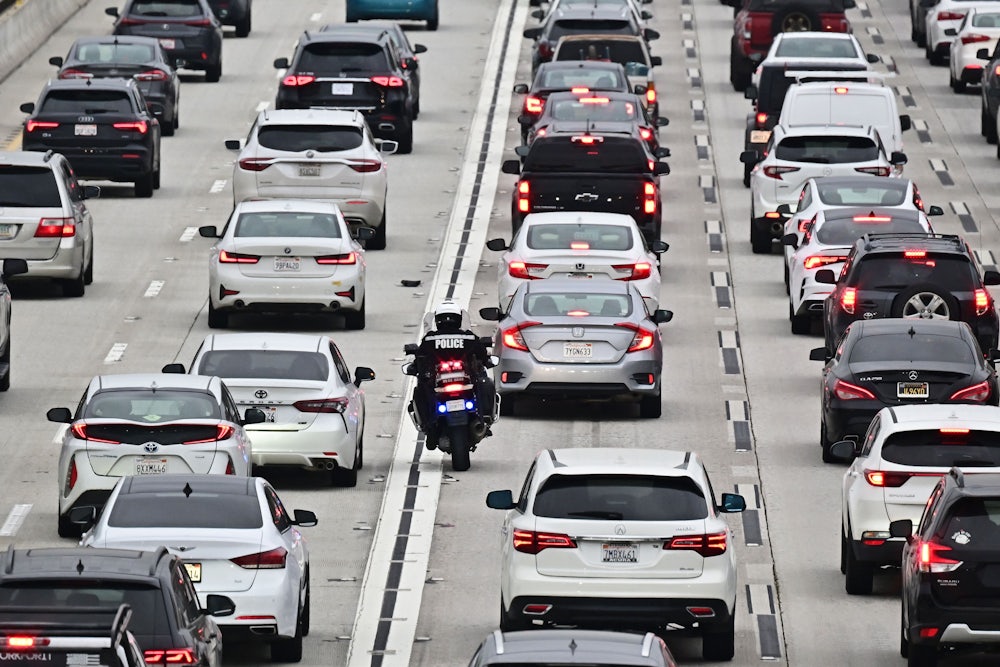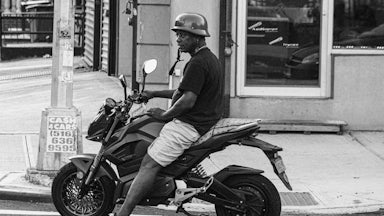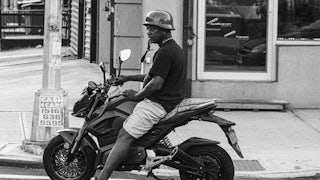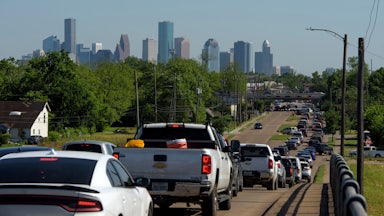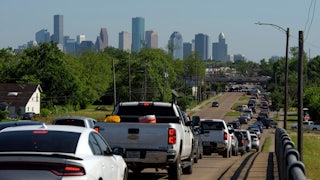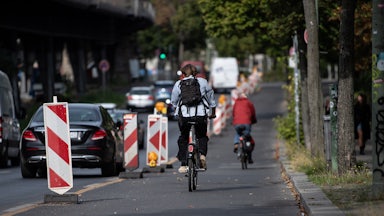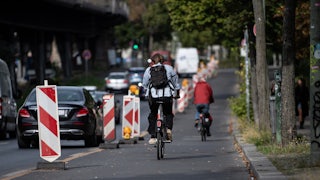The time drivers waste in traffic disproves the idea that car culture maximizes individual freedom, social philosopher and journalist Andreas Gorz argued in his 1973 essay “The Social Ideology of the Motorcar.” “In the final analysis,” Gorz wrote, “the car wastes more time than it saves and creates more distance than it overcomes. Of course, you can get yourself to work doing 60 mph, but that’s because you live 30 miles from your job and are willing to give half an hour to the last 6 miles.”
The many efforts to change this by easing congestion haven’t worked. In 2015, California completed a $1.6 billion project to widen a perpetually clogged 10-mile portion of the 405 Freeway. Four years later, there was no improvement: Travel times either remained the same or got worse, depending on the time of day. Induced demand—the theory that widening roads to speed up traffic almost always results in more cars and more congestion—was proven right.
If we want to save the time we currently spend in cars, the simplest way to do that is to reduce the distance cars have created in our built environment: Proximity, not horsepower, enables freedom and convenience. This is the heart of an idea called the 15-minute city.
Conceived in 2016 by Carlos Moreno, a professor at the Sorbonne, the 15-minute city is a conceptual blueprint for urban planning where most people’s daily needs—including schools, shopping, work, and more—are located within a short walk or bicycle ride from just about anywhere. Cars are not banned but tamed, with street designs that discourage their use for all but essential trips. Without the need to burn fossil fuels to buy groceries or take children to school, air pollution and carbon emissions are greatly reduced. Residents experience better health outcomes and improved quality of life.
Moreno’s catchall term for this idea is novel, but the ideas behind it are not; they draw on principles that have organized human civilizations for millennia, at least until the twentieth century, when the automobile disrupted everything. In the 1920s, partially in response to the rise of cars, American urban planner Clarence Perry proposed the “neighborhood unit,” in which a central municipal building such as a school would form the center of a circle with a quarter-mile radius. Streets within the circle would be designed to discourage through traffic and promote walking for most daily needs. (It takes about 10 to 15 minutes for the average human to walk a half-mile, the diameter of Perry’s circular unit.)
In the mid-1990s, the New Urbanism movement, which advocates for “human-scaled” developments, informed the design and construction of the planned community of Celebration, Florida, which features sidewalk-lined streets with various housing types, shopping close by, and charming parks and public spaces, all easily accessible on foot. The Congress for New Urbanism, a collection of planners, policymakers, and activists in the movement, believes that even at a micro level, neighborhoods should be “designed around a five-minute walk from center to edge.”
In 2010, to help tackle congestion and meet its sustainability goals, planners in Portland, Oregon, proposed building “20-minute neighborhoods,” where people could walk and bike to most destinations. In 2015, Boulder, Colorado, shaved five minutes off Portland’s idea, including 15-minute cities in its Comprehensive Housing Plan to create more mixed-use, affordable development.
Last year, officials in the English city of Oxford decided to do something about the “unnecessary journeys by cars” that choke its medieval streets. With goals of improved bus service, safer cycling, and reduced carbon emissions, Oxford officials proposed dividing the city into six zones and using a system of permits, license plate readers, and other restrictions to limit driving trips. Residents with cars would receive 100 passes per year to drive between zones, with exceptions granted for taxis, delivery vehicles, drivers with disabilities, and others. Those traveling via bus, bike, and foot would not be affected.
To say that the plan was met with outrage would be an understatement. Councillors were accused of attempting to restrict not just driving but freedom itself. Right-wing commentator Katie Hopkins told her YouTube audience that the Oxford plan was part of a government plot to enact “coercive control” over ordinary citizens that would result in people being confined to their designated zone and send society down a slippery slope to more draconian limits on individual autonomy.
A tweet from Jordan Peterson, the Canadian psychologist and media personality, added fuel to the fire. “The idea that neighborhoods should be walkable is lovely,” he wrote in December. “The idea that idiot tyrannical bureaucrats can decide by fiat where you’re ‘allowed’ to drive is perhaps the worst imaginable perversion of that idea—and, make no mistake, it’s part of a well-documented plan.”
Protests in Oxford soon erupted, with demonstrators carrying signs accusing the council of conspiring with global elites at the World Economic Forum to limit personal mobility. Almost immediately, through the vast grapevine that is social media and cable news, the 15-minute city concept became the focus of a broader backlash. Mark Dolan, a commentator for GB News, warned viewers that they would soon only be allowed to leave their homes for periods of 15 minutes. During a debate in the U.K. Parliament, the conservative member of Parliament complained that 15-minute cities were “an international socialist concept” with no place in a free Britain.
In the United States, Laura Ingraham and Tucker Carlson got in on the act, sounding the alarm that what started with Covid lockdowns would soon turn into climate lockdowns, with guests stating that the 15-minute city idea was all part of the plan. Thanks to the global attention, Moreno has received death threats. The councillors in Oxford had to issue a video statement calling for a return to rationality, but little seems to have helped lower the temperature.
Usually there’s a one-to-one connection between a city’s plan to reduce car dominance and the negative reaction it provokes. For example: local merchants saying that removing parking to install bike lanes will hurt their bottom line. The reaction to Oxford’s plan, however, and the way in which the 15-minute city has metastasized into a right-wing bogeyman, is a massive escalation that takes the debate from typical complaints about a “war on cars” into a QAnon-style fever swamp. Sadly, it could be a preview of what’s to come as the world attempts to avoid climate catastrophe.
There are many reasons that reasonable, life-improving policies to reform America’s car culture may languish in culture-war purgatory. First, there is no concept that cannot be plucked from obscurity by the right and elevated to conspiracy—witness, for example, the movement’s success at turning ignorance about “critical race theory” into bans on books featuring Black characters and historical figures. The urban planning world is filled with concepts that are just as exploitable. The science of climate change, which has already been the subject of decades of disinformation, faces an even bigger challenge fighting back against bad-faith actors.
Second, while it’s true that institutional change is a better tool for fighting climate change than individual behavior, some institutional change will require individuals to change their behavior—which they frequently resist. Oxford wanted to speed up buses, for example. That requires fewer cars in the way, which requires institutional changes that make driving more difficult. The institutional change needed to fight global warming will also require behavior shifts: Given that the transportation sector and private car ownership represent a huge chunk of the world’s climate emissions, there’s no path to limiting warming that doesn’t involve reducing driving. Unfortunately, few motorists are willing to agree with Gorz and redefine their definitions of freedom to make the switch to transit, cycling, and walking, even if doing so would save them time.
Third, Covid-related mask mandates and vaccine requirements unleashed a new level of conspiratorial thinking, even among those not otherwise inclined toward it. You might not be aware of any plot to force people out of their cars right now, the thinking goes, but in 2019 there was no plan to force people to stay in their homes or get a needle in their arm. Who’s to say what will be next?
Fourth, the death threats received by Moreno and the vitriol leveled at officials in Oxford by angry protesters may make leaders in other cities wary of pursuing policies that address traffic congestion, climate change, or any related issue. If making it easier for people to walk to the grocery store or ride the bus can provoke this kind of reaction, would any elected official want to take the risk?
Thankfully, many policymakers are still willing to brave the backlash in pursuit of more livable and sustainable neighborhoods. And there are lessons to be learned and ways to navigate the situation to minimize a plan’s potential to become fodder for right-wing media and conspiracy theorists.
One of the mistakes Oxford officials made was the gap between deliberating the plan and implementing it. It was approved in 2022 but won’t go into effect until 2024. That’s left a lot of time for fearmongering and conspiratorial thinking to flourish. Oxford’s plan was also overly complex; any scheme involving license plate readers and permits and dividing a city into designated zones is bound to evoke thoughts of an Orwellian surveillance state. Speeding up what might be called “bureaucratic time” and simplifying traffic-circulation and safety plans to get them up and running quickly won’t eliminate conspiracies or stop bad-faith actors from making hay, but it will give them less time to do damage.
When people flock to a pedestrian plaza, bike lane network, or faster bus system, it can help combat the notion that such changes have been forced upon an unwilling populace by tyrannical global elites. It makes those protesting 15-minute cities—ironically by walking on streets free of automobile traffic—seem silly and puts such conspiratorial thinking back on the fringe, where it belongs.
Ultimately, the best way to spread enthusiasm for these reforms may lie in the through line between Gorz’s essay and Moreno’s 15-minute city proposal: by reevaluating our relationship with time itself. The ability to use one’s time as one sees fit—for example, without being forced to waste countless hours in traffic—is the ultimate freedom. Those who unshackle themselves from the burdens of driving will have a lot more of it.
